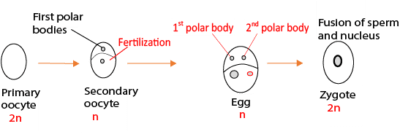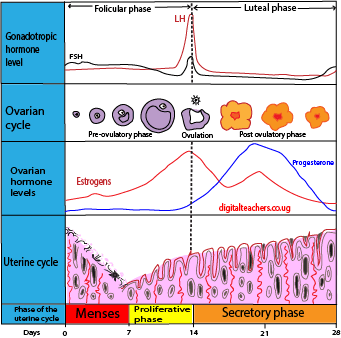
Reproduction in animals (A-level Biology)

Essential features of sexual reproduction involve a set of events. They can be summarized as follows:
- Attainment of sexual maturity by an organism
- The process of gametogenesis, i.e. production of gametes
- The liberation of these gametes and coming together.
- The fertilization process.
- Attainment of maturity
Sexual maturity is said to reach when the gametes producing organs or gonads and associated sex organs are fully functional. Usually, gonads are the last organs to mature.
Human male reproductive system




Both the male and the female reproductive system consists essentially of a tube- the genital tract, which runs from the gonads (ovary or testis) to the exterior. The gonads and tube leading from them are paired. The tubes converge in the middle to form a single median tube which leads to the exterior.
The main parts of the female genital tract are
- Oviduct which runs from the ovaries to
- Uterus whose end, the cervix, leading to
- The vagina runs to the exterior.
The main parts of the male genital tract are
- The vas deferens which runs from each testis to
- Urethra which runs down the penis to the exterior. Important glands (i.e. seminal vesicle, prostate and Cowper gland) open into the vas deferens and the urethra; they produce secretions that mix with sperm that activate sperms and keep them in viable and motile state.
Gametogenesis
This is the formation of gametes. Sperm formation is called spermatogenesis while egg formation is called oogenesis.
Spermatogenesis
- Spermatogenesis in man occurs in the testis;
- Primordial germ cells (2n) divide mitotically to form spermatogonia that grow into primary spermatocyte (gamete forming cells) with 46 chromosomes
- Primary spermatocytes undergo the first meiotic division to form two secondary spermatocytes (n), each with 23 chromosomes.
- The secondary spermatocyte undergoes a second meiotic division to produce spermatids (n), each with 23 chromosomes.
- Spermatids then differentiate into sperms (spermatozoa).
- The process of meiosis in male always result in four cells that become sperms.

Oogenesis
- Oogenesis occurs in the overlies of female,
- Primordial germ cells (2n) divide mitotically to form oogonia the grow into primary oocytes (2n)
- primary oocytes undergo the first meiotic division to form two haploid cells each having 23 chromosomes. One of these cells termed the secondary oocyte (n) receives almost all the cytoplasm. The other is a polar body that may disintegrate or may divide again.
- The secondary oocyte begins meiosis II and stops at metaphase II.
- Then at ovulation, it leaves the ovary and enters an oviduct where it may be approached by a sperm.
- If sperm enters the oocyte, it activates to continue meiosis II to completions. The mature egg has 23 chromosomes. Meiosis in females produces only one egg and possibly three polar bodies.
- The polar bodies are used to discard unnecessary chromosomes while retaining much of the cytoplasm in the egg.
- The cytoplasm serves as a source of nutrients to the developing embryo.






| NB. – Acrosome produces enzymes that enable the sperm to penetrate the egg Mitochondria generate energy/Axial filament is used for propulsion |
Comparison of gamete formation in male and female organs in man
| Male organ | Female organ | |
| 1. | Production of sperms begins at puberty | Production of ova begins before birth completed after fertilization |
| 2. | Several primordial germ cells divided repeatedly by meiosis forming diploid spermatogonia | One primordial germ cell repeatedly divides by mitosis to form diploid oogonia |
| 3. | All separate spermatogonia increase in size to form spermatocytes | One of the resulting oogonia enlarges to form primary oocyte the other degenerate |
| 4. | Each primary spermatocyte undergoes the 1st meiotic division to form two secondary spermatocytes which immediately undergo 2nd meiotic division to give rise to spermatids | The primary oocyte undergoes meiosis, unequal division. 1st meiotic gives rise to secondary oocyte with a smaller polar body. The second meiotic division proceeds as far as metaphase but does not continue until a sperm fuse with the oocyte. At fertilization, the 2nd meiotic division produces a large cell the ovum and a second polar body. |
| 5. | Each spermatid differentiates into a spermatozoon | The ovum does not undergo further differentiation and their polar bodies degenerate |
| 6. | A large number of sperms is formed from one primordial cell | One ovum formed from one primordial cell |
Feature leading to variations in sexual reproduction
- Reciprocal crossing over of genes between chromatids of homologous chromosomes may occur during prophase I of meiosis. This produces new linkage groups and provides some major sources of the genetic recombination of alleles.
- The orientation of chromatids of homologous chromosomes (bivalents) on the equatorial spindle during metaphase I determine the direction in which the pairs of chromatids move during anaphase I. this orientation is random
- During metaphase II the orientation of a pair of chromatid is also random and determines which chromosome migrate to opposite poles of the cell during anaphase II. These random orientations and subsequent independent assortment (segregation) of chromosomes give rise to a large calculable number of different chromosomes combination in the gametes
- The fusion of male gametes and female gametes to produce diploid gametes is also randomly leading to variation
Fertilization
This is the union of the male and female gametes. It occurs about a third of the way along the oviduct. After fertilization, the zygote is pushed down the oviduct by gentle contraction of the circular muscle in the oviduct wall. Once the egg has been successfully fertilized, conception is achieved. The embryo then develops into a fetus. The period taken between conception to delivery varies from species to species, inhuman it is 9months. Within a few days of implantation, the nourishment of the embryo is taken over by the placenta.
Internal fertilization
This is the union of male and female gametes inside female animal
The advantages and disadvantages of internal fertilization
Advantages
• more chances of fertilization
• fewer predators of oval/fertilized egg protected in females body
• stable internal environment
• fewer gametes required
• eggs/fetus protected from dehydration
• The embryo is protected and nourished by the female (mammals only)
Disadvantages
• number of gametes fewer hence less number of offspring
• less adapted for the sudden change of environment after birth
• in mammals females suffer gestation stress
The menstruation/ sexual/ oestrus cycle
This cycle found in the female; ensures that female reproductive physiology events are synchronized. For the uterus prepares itself for implantation before ovulation.
The events that occur in the course of the cycle follow a set of a regulated pattern by a hormone which is produced by the pituitary gland and the ovary. A complete cycle takes about 28 days. If pregnancy occurs the cycle is interrupted by other hormones produced by the placenta. The woman is most likely to get pregnant between 12th and the 17th day from the onset of menstruation.
Hormonal control of the cycle
Pituitary hormones secreted by the anterior lobe of the pituitary gland are Follicle stimulation hormones (FSH) and luteinizing hormone (LH).
Ovarian hormones produced by the ovary are estrogen and progesterone.`
The menstrual cycle of the human female showing the events occurring in ovary together with relative levels of estrogen and progesterone.


- Just after menstruation, the anterior lobe of the pituitary gland starts secreting FSH.
- FSH causes a Graafian follicle to develop in the ovary to secrete estrogen.
- Oestrogen
(i) brings about the healing and repair of uterine endometrium
(ii) Inhibits production of follicle-stimulating hormone (FSH)
(iii) stimulates production luteinizing hormone (LH)
In the course of 11 days or so the amount of estrogen in the bloodstream steadily increases. Then shortly before evolution takes place, LH is released.
4.. LH (luteinizing hormone)
(i) causes ovulation
(ii) promotes the development of Graafian follicle int a corpus luteum to secrete progesterone
5. The corpus luteum secretes progesterone
6. Progesterone
(i) this along with estrogen, cause the continued thickening and vascularization of the uterine endometrium in preparation for implantation
(ii) inhibits the secretion of LH leading to a degeneration of corpus luteum
7. For a week or so after ovulation, the concentration of progesterone and estrogen gradually increases and then suddenly decrease.
8. With the fall in the levels of the two hormones, the uterine endometrium begins to disintegrate and menstruation and the cycle repeats
In the events of pregnancy
Implantation
Following fertilization, the zygote divides (cleavage) mitotically until a hollow ball of cells, the blastocyst is produced. It takes three days to reach the uterus and a further three or four days to become implanted in the lining of the uterus. The outer layer of the blastocyst, called the trophoblast, develops into embryonic membranes, the chorion, and amnion.
The chorion develops villi which grow into the surrounding uterine tissue from which they absorb nutrients. These will form part of the placenta which is connected to the fetus by the umbilical cord.
The amnion develops as a membrane around the fetus and encloses the amniotic fluids, a watery liquid that protects the fetus by cushioning it from physical damage.
The corpus luteum persists due to the secretion of a hormone called chorionic gonadotropin by the placenta. This hormone signals to the mother’s body that an embryo is present in the uterus.
The corpus luteum continues to secrete progesterone which coupled with the small but steady secretion of estrogen, maintains the continued development of the uterus and prevents menstruation.
After the first three or four months of pregnancy, the corpus luteum begins to regress and the job of secreting estrogen and progesterone is to take over by the placenta.
In this way, the endometrium is maintained in a suitable state throughout pregnancy.
The placenta

The placenta is a disc-shaped organ that provides the sole physical link between mother and fetus.
From the outer surface of the chorion, a number of finger-like projections known as chorionic villi grow into the tissue of the uterus. These villi penetrate the tissue of the uterine wall of the mother and form the placenta
Functions of the placenta
- It allows the exchange of materials between the mother and fetus without the two-blood mixing
- Oxygen, water, amino acid, glucose, and other essential minerals are transferred from the mother to the fetus
- Carbon dioxide, urea, and other wastes are transferred from fetal blood to the mother’s blood.
- Prevents certain pathogens from entering fetal blood
- Produces HCG
- It allows certain maternal hormones to cross to the fetus.
Adaptations of the placenta to its functions
- Rich blood supply allows absorbs necessary nutrients and deliver waste products to the mother’s drug
- Has villi that increase surface area for exchange of material
- Placental blood has a high affinity for oxygen
- The thin membrane reduces the diffusion distance
- High blood supply
- Blood capillaries of the fetus and mother flow in opposite direction (counter-current system) to maintain the diffusion gradient.
- Contain numerous mitochondria to provide energy for active transport.
Why should mother’s and fetal blood not mix
- To prevent blood incompatibility due to different blood group
- To prevent incompatibility due to different rhesus factors
- To prevent infections from the mother attacking the fetus
- To protect the fetus from a high blood pressure of the blood of the other
The hormonal control of birth
Towards the end of pregnancy, the levels of estrogen in the blood rise while that of progesterone falls. It has been suggested that this plays some part in bringing about birth. Indeed, estrogen promotes uterine contraction whereas progesterone doesn’t.
But the most direct cause of birth in another hormone, oxytocin secreted by the posterior lobe of the pituitary gland that causes uterine muscle contraction.
Oestrogen and progesterone are also responsible for the growth of the mammary gland in preparation for milk production (lactation). After birth, milk flow is initiated by a hormone called prolactin secreted by the anterior lobe of the pituitary gland.
Summary of effects of estrogen during pregnancy
- promotes the growth of mammary glands
- inhibits FSH release
- Inhibits prolactin release
- Prevents implantation in the uterus
- Increases size of the uterine muscle
- Increase ATP and creatine formation
- Increase sensitivity of the myometrium to oxytocin
Summary of effects of progesterone during pregnancy
- Growth of mammary glands
- Inhibits FH release
- Inhibits prolactin release
- Inhibits contraction of the myometrium
NB: The fall of progesterone during gestation causes miscarriage as the uterine contraction are no longer inhibited.
Hormonal control of spermatogenesis
- The hypothalamus secretes gonadotrophin-releasing hormone or GnRH, that stimulates the anterior pituitary gland to produce the gonadotrophic hormones, i.e. Luteinising hormone (LH) and follicle-stimulating hormone (FSH).
- FSH promotes spermatogenesis in the seminiferous tubes. The hormone actually regulates the puberty age and also plays a vital role in the production of sperm. It also stimulates the maturation of germ cells in both males and females
- LH or interstitial cell-stimulating hormone (ICSH) stimulates the production of testosterone by the interstitial cells.
- Testosterone which is produced in the Leydig cells of the testicles becomes responsible for the maturation of the sperm while the production goes on. It also brings about normal development and functioning of testis and secondary sexual.
Infertility
Infertility means not being able to get pregnant after one year of trying (or six months if a woman is 35 or older). Women who can get pregnant but are unable to stay pregnant may also be infertile.
Infertility in men is most often caused by:
- A problem called varicocele (VAIR-ih-koh-seel). This happens when the veins on a man’s testicle(s) are too large. This heats the testicles. The heat can affect the number or shape of the sperm.
- Other factors that cause a man to make too few sperm or none at all.
- Movement of the sperm. This may be caused by the shape of the sperm. Sometimes injuries or other damage to the reproductive system block the sperm.
- Sometimes a man is born with the problems that affect his sperm. Other times problems start later in life due to illness or injury. For example, cystic fibrosis often causes infertility in men
- importance
Infertility in women is most often caused by:
- Failure of ovulation
Most cases of female infertility are caused by problems with ovulation. Without ovulation, there are no eggs to be fertilized. Some signs that a woman is not ovulating normally include irregular or absent menstrual periods. Ovulation problems are often caused by polycystic ovarian syndrome (PCOS). PCOS is a hormone imbalance problem that can interfere with normal ovulation. PCOS is the most common cause of female infertility. Primary ovarian insufficiency (POI) is another cause of ovulation problems. POI occurs when a woman’s ovaries stop working normally before she is 40. POI is not the same as early menopause
2. Damage to fallopian tubes such blocked fallopian tubes due to pelvic inflammatory disease, endometriosis, or surgery for an ectopic pregnancy
3. Damage to the uterus such as uterine fibroids, which are non-cancerous clumps of tissue and muscle on the walls of the uterus.
4. Problems with the cervix, some women have a condition that prevents sperm from passing through the cervical canal
5. Age can contribute to infertility because as a woman ages, her fertility naturally tends to decrease.
6. Some women have polyps and fibroids that interfere with implantations
7. Incorrect frequency and or timing of intercourse may make conception unlikely and couples may need to be counselled on the most appropriate time when ovulation is likely.
Similarities between sexual reproduction in flowering plants and animal
- Gamete formation
- Start from germ cells/unfertilised sell
- Gamete formation is by meiosis
- More than one male gamete is formed from one germ cell
- Male and female gametes are haploid
- Male gametes are smaller than female gametes
- Gamete transmission
- Male gamete moves towards an ovum by chemical attraction
- Fertilization
- Syngamy (fusion of nuclei) occurs
- Only one male gamete fuse with an ovum to forms single embryo
- Male gametes digest their way through the walls of the ovum
- Development and production
- The embryo is nourished through the same embryo sac
- Offspring show variation from the parents
Differences between sexual reproduction in flowering plants and animal
- Most animals are dioecious whereas most plants are monoecious
- In plants, reproductive organs are temporary but in animals are permanent and function throughout their lives
- In plants, male gamete require an agent whereas in animals there is copulation
- In plants, male gamete reaches ova by developing tubes, but male gametes in animals ae motile.
- In plants, double fertilization occurs which does not occur in single animals
Methods of contraception
These are birth control to prevent unwanted pregnancy
Methods of contraception include:
- long-acting reversible contraception, such as the implant or intrauterine device (IUD)
- hormonal contraception, such as the pill or the Depo Provera injection.
- barrier methods, such as condoms.
- emergency contraception.
- fertility awareness.
For revision question and marking guide download:
Reproduction in animals (A-level)
Please find free downloadable notes, exams and marking guides of agriculture, biology, Physics, chemistry etc. from digitalteachers.co.ug website.
Dr. Bbosa Science

Thank you for your post.Really looking forward to read more. Awesome.
Your content is always worth the read. Baby Products
I’m excited to see where you’ll go next. Indian Football
Get insights into affordable options with the MBBS Fees Structure in Rajasthan.